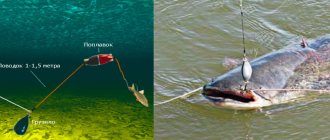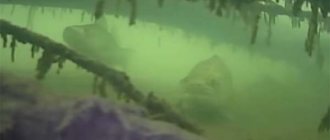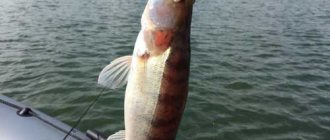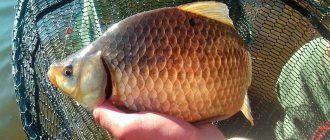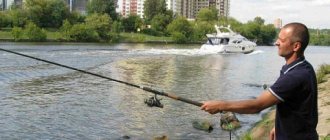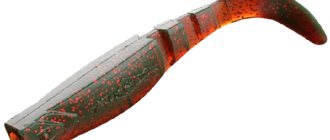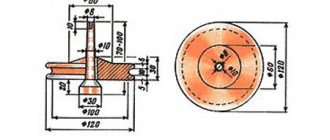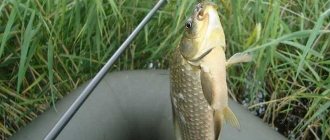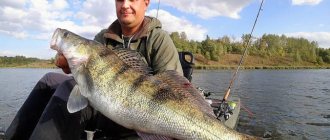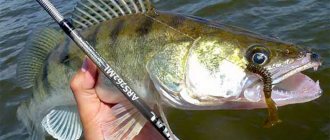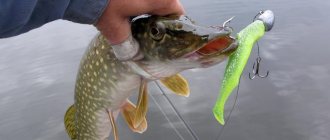Pike perch is one of the most common predators living in the reservoirs of our country. This fish has enormous industrial value, and catching it is not only beneficial, but also a pleasure.
Almost every fisherman sooner or later encounters a fanged one and admires its agility and excitement when catching it. Due to the peculiarities of their behavior, jig baits are most often used when catching pike perch.
About pike perch and its habits
As mentioned earlier, pike perch is a desirable predator among spinning fishermen and a formidable predator for young fish, the morals of which are legendary among many fishermen. This fish leads a sedentary lifestyle.
Pike perch spends most of its time at the bottom, where it hunts and rests. Spawning of pike perch begins in early April and ends in early May. Spawning is also characterized by a long feeding period, which plays into the hands of many fishermen. Pike perch is not a picky fish. It is only important to correctly determine the places of its parking.
This predator can be caught with almost all existing baits designed for catching predators. It is also worth noting that pike perch’s appetite is simply brutal. It definitely exceeds the appetite of perch and often even pike. Mostly pike perch are caught using silicone baits and jig tackle, which will be discussed further.
Pike perch sites on the river depending on water level
Pike perch bite on silicone almost every time of the year. This fish does not hibernate and is active during periods of zhora, which take place in early spring (from late March to mid-May) and autumn (from late August to late October). After this, the pike perch begins to experience some kind of calm.
The fish adapts a little to the cold and already during the freeze-up period begins to show its former activity. Thus, catching pike perch is always possible throughout the year, but it is important to pay special attention to baits, because the outcome of the entire fishing will completely depend on them.
Pike-perch stops in large bodies of water - this is important to consider when fishing for fangs using silicone
in autumn
At the end of summer and, especially at the beginning of autumn, pike perch become active and now hunt in the daytime, although, of course, morning and evening dawns remain the most favorable periods for catching pike perch. Autumn differs from the spring period in the longer duration of fishing, since you can catch pike perch with a spinning rod before the first ice. Moreover, at this time, as well as in the spring, trophy fish are often caught. But in late autumn, heavier and larger baits are used. And preference is given to jig fishing, where foam fish and silicone baits are used. Glowing large vibrotails, twisters and worms are often used for deep fishing. Oscillating spoons are also used successfully, but the most suitable are heavy baits that work near the bottom, which is facilitated by a shortened, stepped retrieve.
For pike perch with spinners and spoons
Catch pike perch on a jig
The principle of choosing jig baits for pike perch depending on fishing conditions
Choosing the right bait to catch any fish is an art. Although pike perch is not one of the pickiest fish, it definitely has certain taste preferences, so you need to carefully choose a silicone bait before fishing, and also choose the right jig tackle.
So, let's consider the most important factors on the basis of which the right choice of rubber bait is made when catching fanged fish.
Selection of baits for pike perch depending on the body of water
The choice of bait based on the characteristics of the reservoir where fishing will be done is important.
In particular, it is necessary to determine what kind of relief, depth and current the reservoir has.
If the reservoir is relatively shallow and does not have a large current, like most small ponds and rivers, then the choice should be given to microjig.
Almost always the same micro-pike perch goes to microjig
If the reservoir has a depth of 3 to 5 meters, as well as a medium-fast current, then a medium jig weighing from 10 to 20 grams is perfect. In most cases, the bait itself is an edible vibrotail or made from ordinary rubber, 5 to 10 cm long, brightly colored.
If the reservoir is characterized by relatively deep depth and fast current, then large models of silicone baits on jig heads from 20 to 35 grams are perfect. The bait itself, a vibrotail, worm, slug, or foam fish, should have medium or large sizes from 10 to 15 cm.
Small and medium slugs are used on offsets and with bullet-type loads when fishing for pike perch in snags on rivers
It is necessary to choose the weight and size of the bait by correlating them with the depth, size and characteristics of the flow of the reservoir, since it is precisely these features that affect the game of the bait, the speed of its penetration, the accuracy of the fall, etc.
Depending on the time of day
Time of day is also an important criterion that should be taken into account when choosing pike perch bait. As you know, pike perch is capable of hunting both during the daytime and at night.
Typically, anglers catch pike perch during daylight hours, but night fishing can also show high results.
For daytime fishing, you can choose a vibrotail of bright colors: red, orange, yellow. These are the most favorite colors of pike perch, especially in clear water.
During night fishing, spinning fishermen slightly change their tactics. They prefer to choose jigging rubber impregnated with flavors. Acid colors and also rubber in the form of edible slugs and worms also work well at night, but to use it you need to have good command of the tackle in order to make the game as attractive and unique as possible. These are passive baits without their own animation and the fisherman sets the game for them.
Depending on the time of year
Pike perch is a predator that can be caught successfully throughout the year. In most cases, when fishing for pike perch, preference is given to baits of bright colors.
In the mud that appears on the bottom from playing with the bait, the pike perch will not react so sharply to the brightness of the bait, but on the contrary, it will see and show interest. However, sometimes the choice is given in favor of other baits.
In spring and autumn, when fishing for pike perch, anglers equip their gear with rather aggressive colored vibrotails, with an active game of their own, because they show the greatest efficiency.
The vibrotail not only allows for active fishing at different depths of the reservoir, depending on the weight of the jig head, but is also very inexpensive compared to other rubber baits.
Also in spring and autumn, foam fish of medium and large sizes are popular. These baits quickly sink to the bottom and can rarely catch on third-party water bodies, because they are usually equipped with single jig heads, offset hooks, and, much less often, double hooks. The most catchy colors are purple, blue, white-red and orange.
Spring and autumn pike perch prefer aggressive colors
In summer, catching pike perch is made difficult by a deterioration in its appetite, overgrowing of reservoirs and unfavorable weather. For daytime summer fishing, it is customary to choose non-provocative colors: brown, gray, black, green. Smaller foam rubbers, nozzles in the form of large insects or worms are used, but for them you need to have special animation skills
Catching pike perch at different times of the year
Pike perch is the most popular commercial fish. It has a long and thin body, a wide mouth and sharp pike-like teeth. Near the dorsal fin, the pike perch is gray-green. The belly of the fish is white or pale pink, and there are dark spots on the sides. The color of pike perch, as a rule, depends on the area where the fish lives: in the southern latitudes of Russia it is painted in dark colors, and in the northern latitudes it is painted in lighter colors.
Pike perch is the largest spiny-finned fish. Usually the maximum weight of a fish that can be caught is about 2 kg, but in large deep lakes there have also been 5-kilogram specimens, and sometimes even 10-kilogram ones! Particularly lucky fishermen managed to catch pike perch weighing more than 10 kg, but this happened extremely rarely.
Fishing for walleye varies greatly at one time or another of the year. Let's take a closer look at how to properly catch pike perch at different times of the year.
Fishing for pike perch in spring
The spring season of pike perch is characterized by a good bite when fishing on front-loaded spinners. This bait performed well in muddy, opaque water, because it is a noisy bait, and the pike perch simply does not notice it.
From mid-April to mid-May, pike perch are good on spinning rods. This is explained by the fact that it is during this period that the fish is attacked by an active zhor, so the fisherman has a high chance of catching a respectable specimen. This time of year is considered the most productive fishing period of all others. In the second ten days of May, pike perch finishes spawning, and until the end of the month it becomes difficult to catch large fish. As a rule, you can catch pike perch weighing up to 0.5 kg.
In spring, pike perch are caught rarely and very unstably. The bite can continue throughout the spring, or maybe just for a couple of days. Pike perch, like any other predatory fish, grabs the bait on the fly, so it does not have time to sink to the bottom. Due to the large amount of food available to pike perch, it usually bites the bait very rarely. However, after the water recedes, when the current carries away small fish, the pike perch will not miss the opportunity to eat and will take any bait.
In spring, pike perch can be caught both from the shore and from a boat. When choosing a place for fishing, you need to remember that the depth should not exceed 5 meters. It is better to choose a strong fishing rod, a strong fishing line (slightly longer than the rod), and a wooden float (the size of a small egg). In this case, you need to choose a sinker so that it holds the float in a vertical position. When catching pike perch from the fishing line, a hook is used to pull out the fish. Using a net is not recommended. Often, pike perch cling to the gills or belly (in the area of the pectoral fins). Long line can only be used for boat fishing or in clean areas, that is, where the chances of getting caught are minimal.
The pike perch bite in spring is quite varied. In a fast current, the float often moves sharply to the side, sometimes it sinks sharply or slowly sinks into the water, which is reminiscent of a perch bite. When fishing in such places, it is better to use dead fish as bait, supporting it with rotational movements.
Fishing for pike perch in summer
The summer period for catching pike perch begins in mid-late May and lasts until mid-August. At the same time, the fish bite better in the evening or at night. This is due to the fact that pike perch is a predatory fish and usually hunts in the dark. It loves clean water, well saturated with oxygen, so to catch it you need to choose clean rivers or flowing reservoirs. Typically, pike perch stays near slopes, dams, and flooded bridges, avoiding coastal thickets. It is more likely to catch walleye in an area with a sandy or rocky bottom rather than a silty one.
The technique for catching pike perch in summer is not much different from catching pike. For successful pike perch fishing, it is recommended to fish with narrow-shaped live bait. If you prefer to fish with a spoon, then it should also be narrow, oscillating, preferably light in color. The lure needs to be led smoothly and slowly: since the pike perch ambushes its victims, with a fast retrieve it simply will not have time to grab the bait.
When fishing for pike perch, it is also not recommended to use a metal leash, since the predator does not bite the fishing line. It is better to catch pike perch from a stable boat, because although small specimens behave passively, large specimens will strongly resist in any case. If you are planning to go fishing for pike perch, you will need to study the bottom of the reservoir in detail and choose the right echo sounder.
In addition, in the summer, pike perch are often caught using donka or mugs. The gear is installed in the evening, and the catch is checked in the morning. This type of fishing is certainly successful, but not the most passionate and interesting. Losing mugs at dusk is common, so it is not recommended to use them in excess.
Fishing for pike perch in autumn
Autumn fishing for pike perch begins in mid-August, and its peak falls at the beginning of September. In the fall, pike perch is most often taken on a jig. In early to mid-October, the predator begins to look for wintering places and gradually goes deeper, thereby reducing the effectiveness of using jigs.
With the first cold snap, the pike perch is attacked by a wild zhor, the longest of the entire year. It starts in October and ends by mid-November. It is during this period that very large specimens are found. Of course, the biting activity will be lower than in the pre-spawning period, but if the location of the pike perch is correctly determined, catching it will not be difficult.
For autumn fishing for pike perch, jig baits, heavy oscillating spoons, as well as foam rubber and polyurethane foam fish are often used. In November, it becomes more difficult to catch pike perch, but about a week before frost, large specimens are often caught.
In autumn, pike perch usually stays in the lower reaches of rivers and does not go into pits to overwinter. The fish, gathering in large schools, stay at a depth of 2-3 meters, and at the right time they move out into the river.
Fishing for pike perch in winter
This fishing season begins with the appearance of ice. Unfortunately, you can catch pike perch in winter only on “heated” rivers - those that pass through the entire city. This is explained by the fact that the river, flowing through the entire city, receives various types of waste. The water temperature rises noticeably, and the river does not freeze completely.
An acceptable bite for pike perch begins at the end of February, when the ice begins to melt and the rivers open up. In winter, pike perch is caught in the area of pits, and you can use spoons or live bait. When fishing in some places, spinners give better results than live bait.
Good luck with your pike perch hunt and trophy catches!
Equipment and rigs for jig baits
An important point for spinning fishing is the correct assembly of the gear, which includes mounting the bait and choosing a certain type of bait among the rest.
Despite the fact that there are a huge variety of jig baits, they are installed identically in most cases, but you can use several different options in which different baits are installed in different situations.
The most common installations of silicone baits when fishing for pike perch are the classic jig head and Cheburashka.
Installation on Cheburashka
Hinged mounting on an eared sinker
Rigid mounting on jig head
So-called spaced installations are also used. So, there are two most common types of spaced jig installation: Carolina and Texas. Let's look at both options in more detail.
Texas rig
Texas is the most popular type of jig rig when fishing for pike perch among snags and stones.
The Texas mounting method involves directly connecting a fishing line to a jig tackle on which a silicone bait is attached. An offset hook is used for installation.
Correct placement of the bait on the offset machine
It is important to note that this bait is attached in the following way: its tip is threaded with a hook and drawn close to the eye of the hook, to the sinker located on the jig.
This equipment does not require any special skill to make it. It is enough just to firmly tie the end of the fishing line or the leash at its end to the jig, and then attach the bait itself.
Carolina rig
The second type of spaced rig is Carolina. This is a much more complex type of equipment, requiring the angler to be able to work with knots and choose the right leash.
The installation consists of attaching the end of the main fishing line first to a bullet-shaped sinker, which will be separated from the hook through a bead, and then attaching a leash in the form of a piece of fishing line/flur to the same sinker.
It should be thinner than the main one, but do not forget that the tackle must be strong in order to withstand fish or hooks among the stones - the fanged one’s favorite anchorage.
When catching large pike perch, it makes sense to use a thin metal leash, which will be much more rational and reliable, given the sharpness of the predator’s teeth and its ability to freely damage the fishing line and, as a result, break off.
Then a hook with silicone or foam rubber bait is attached to the end of the already tied leash. Despite the fact that this installation is more complex, it shows good results in bottom fishing for pike perch.
When the hook is loosely mounted with the bait from the sinker, the play of the bait changes a little and becomes more interesting, which undoubtedly attracts pike perch.
What bait should I use?
Pike perch is not picky about lures and lures. He is attracted by everything actively moving; fishermen have a place to roam and individually select the most catchy bait.
Fishing with live bait brings good results. The pike perch's mouth is small, but has sharp fangs. It is worth considering that having overtaken its prey, the predator swallows it, bites it and releases it, and then repeats the grip again. It sucks up small bait and grabs larger specimens across it.
Better bait (live bait) is called:
- bleak;
- gudgeon;
- dace;
- goby.
It is important that the bait remains alive, otherwise it will not arouse any interest in the pike perch. After the float is flooded, you need to wait a couple of seconds and sharply hook.
Among the artificial baits in demand are:
- twisters;
- vibrotails;
- sinking and floating wobblers;
- foam and plastic fish;
- “oscillators” and rotating spoons.
In the summer, wobblers become the most catchy; their play attracts fish.
Some anglers consider ordinary foil one of the best baits. Long pieces are baited onto a hook and thrown into the water. Its shine imitates the scales of fry, and the flutter of the current resembles their movement.
Jig
To catch pike perch, jig heads are often used - baits with a weight that helps them quickly sink to the bottom. The main condition is the permissible weight; the head must quickly and confidently sink the bait to the bottom so that it does not hang in the water column:
- for standing reservoirs – up to 14 grams;
- with an average flow - from 16 to 24 grams;
- at high currents – up to 40 grams.
The bait is attached to the jig using one of the following methods:
- on a hard jig head;
- sinker on the main line or leash up to 1 meter long;
- on the sinker-Cheburashka.
The pike perch has a small mouth, so you should also take a small bait, no more than 13 cm, otherwise the predator will ignore it. The classic version is orange, white and greenish elements are allowed. Manufacturing material: silicone.
Top 10 best silicone baits for pike perch
This selection will present the most popular jig baits, made of silicone or foam rubber, which have shown excellent results when catching pike perch.
IAM Format Pioneer 88 mm F17
This bait is excellent for catching pike perch in the bottom areas of reservoirs with a high level of aquatic vegetation. The color of the bait is not aggressive, despite the presence of a red tint, concentrated on the belly of the fish.
The green base ensures the plausibility of the visual perception of the bait. The pike perch perceives it as a wounded fish, a fry of bleak or perch, which are precisely its potential prey.
Mikado Fishunter
This is an excellent option for a vibrating tail for catching pike perch in open water at any time of the year.
The vibrotail shows an excellent game, and it can also be used to fish not only the bottom, but also the middle layers of the reservoir. The interesting range of coloring of the model does not alarm the predator, but on the contrary is made more effective due to the stripes on the back.
In the water, the vibrotail is very reminiscent of a small gudgeon - this is exactly what pike perch feeds near the bottom.
Pontoon21 Awaruna and a copy of Kosadaka Awaruna
The vibrotail is made of high-quality silicone and has a very decent weight for such baits - 2 grams.
The form factor and quality of the rubber used allows you to fish not only the bottom, but also the middle layers of the reservoir. The model is used a little less frequently for surface fishing, but with it it is better not to use such bright colors of bait, because they will alert the fish. And pike perch is rarely found in the upper layers of the reservoir.
This model is perfect for fishing in spring and autumn, when pike perch pays special attention to bright baits and is not as shy as in summer. Also, this jig bait works effectively for pike perch at night, but for this it is better to choose flavored edible vibrotails.
Tsuribito Supersoft
An excellent bait for fishing on rivers with moderate currents, which contributes to the best performance of this model.
The vibrotail performs well in interaction with a small current - this makes its play more believable. This model is treated with salt and attractant, which give a special aroma that a predator feels in the water.
Also, on rivers with weak currents, this aroma will spread smoothly and it will be much easier for a predator to find the bait.
Lucky John Pro Series Ballist
The wonderful series of spinning lures from Lucky John never ceases to amaze. This time, twisters in the form of worms, which have more than once helped spinners in catching pike perch in bottom areas, also made it to the top.
Twisters in the shape of worms are less popular than simple foam fish or silicone fish. This is rather a bait recommended for anglers who have at least some experience in jigging. Runaway worms, slugs and other insects require greater realism in the water, which will directly depend on the angler's bait animation skills.
These worms are also impregnated with salt, which makes the predator show greater interest and attracts it from particularly long distances, in combination with the vibration emitted by the bait and the turbidity raised from the bottom.
Select Bugz 3.2
This is a rather interesting silicone model of a bait, effective for catching pike perch, made in the shape of a centipede. While guiding near the bottom stones, the effect of a centipede moving along the bottom is formed.
This incredibly attracts both zander and perch. The silicone has a good action and is treated with salt, which makes it possible to catch a predator that smells the bait from a long distance.
The price for the line of baits from this manufacturer is reasonable. Recommended for fishing in bodies of water with standing water or weak currents.
Rubicon Amal Twister
An ideal bait for catching pike perch in clear water in the spring. Excellent for moderate fishing on the bottom, simulating a small fry or larva.
The model is made of environmentally friendly material and also has a good weight for a silicone product - 2.5 grams. This helps the bait fly further when cast, also making it more resistant to current and the changes in play that come with it.
Keitech Easy Shiner
Well-known among spinning fishermen and a rather bright bait, it works both when fishing in sunny weather and when fishing on a cloudy day. Works great during the spring and summer fishing season.
The bait is made of high-quality materials, therefore it is very resistant to repeated installation. Shows an incredible game, which is responded to not only by pike perch, but also by large perch, as well as small pike.
Soft lures Akkoi Diplomat
The vibrator is designed for catching pike perch in clear water. Excellent for spinning pike perch in the spring and autumn seasons. The bait has a length of about 12 cm, which is a decent indicator for catching pike perch. The model is designed for fishing near-bottom areas with increased current. The color of the bait can be used to catch pike perch on a cloudy summer day.
Lucky John Pro Series Minnow
And our rating of zander rubber is completed by an excellent bait from Lucky John, which is in some ways universal for catching many predators in various conditions.
The coloring of the model is not provocative and does not frighten the predator. Externally, the fish looks like a small gudgeon, roach, which pike perch is used to feeding on. This bait is suitable for both aggressive jerking and moderate, uniform fishing.
Catching pike perch with a jig in spring
Catching pike perch with silicone baits in the spring is very popular. Spring is practically the best time of year for catching this predator. In the spring, pike perch experience a long period of hunger, which is due to its spawning and recovery from cold weather.
At this time, the pike perch is already leaving deep holes for smaller ones, or even going out to feed on shallows and rifts. This is where you should look for the fanged one. It is recommended to choose bright and large baits, because at this time of year the pike perch is not so careful and will take even large baits.
The most catchy colors are: yellow, orange, red, as well as a mix of several of these colors with white or black.
Catching pike perch with jig baits in the summer - June-August
Catching pike perch with a jig in the summer is very different from catching it at other times of the year. From the beginning of summer until the end, pike perch behave cautiously and sluggishly. An increase in water temperature has a bad effect on him and he has to go deeper.
At this time, you need to look for pike perch either at dawn or dusk due to the coolness on the riverbeds and rifts, or during the day in the pits where the fish wait out the hot weather.
In summer, baits should be chosen in a more natural color so as not to spook the fish. They should also be smaller. Vibrating tails, worms, twisters from 5 to 8 cm long are ideal.
Summer colors include acidic, yellow, brown, white, purple, and mixed colors.
Scheme for catching pike perch on the river from a boat - wave-like study of the area
Catching pike perch in the summer with a jig from the shore:
Fishing in autumn
Catching pike perch with a jig in the fall is as good as spring fishing. At this time, the fish again begins to show their former activity, emerging from the pits and snags.
At this time, the water temperature drops, which means that cold weather is approaching. The pike perch senses this and begins to lead an active lifestyle.
In autumn, it is best to look for pike perch in places of dumps, changes in depth, dark shady places in the river with branches hanging from the bank and under dams.
In autumn, you can use large baits and their brighter colors, such as acidic, red, hot pink, white-red and yellow-black, etc. Typically, pike perch prefers moderate fishing with pauses in cold weather. Fishing uses medium and large twisters from 7 to 15 cm, foam rubber, silicone worms and imitations of insects.
Catching pike perch at night with jig baits
Catching walleye at night is quite rare, although effective. This is due to the fact that fishing at night is much more inconvenient than during the day.
However, fishing at night is very important in the summer, when pike perch, due to the constant heat, does not have time to hunt during the day and does it at night.
Often at night, you need to look for pike perch either in small holes or in shallows with little aquatic vegetation. For night fishing, bright and strong-smelling baits are used.
Flavored silicones work great, as do small vibrating tails with salt. The bait should not exceed 10-12 centimeters in size.
It is better to choose red, orange, and white flowers. At night, you can also use balancers, which are used to fish sections of the reservoir from a boat. The greatest activity of pike perch in the dark is observed from 23:00 to 1:00 and from 3:00 to 4:00.
Gear collection
So, it’s time to select and assemble the gear necessary for fishing:
- rod for catching pike perch, because the hooks will be sharp and strong so that you can pierce the fish’s strong jaw. The length of the rod should be from 2.10 to 3 meters.
- Reel It’s better to choose an inertia-free one. It is very easy to use and reliable in practice. Balance reel for the rod, size 2500-3000 Shimano.
- The fishing line should not be excessively thick, but pike perch is a lively fish, although it gets tired quickly. You can use braid with a diameter of 0.12-0.16 mm. For leashes, fluorocarbon fishing line with a diameter of 0.18 to 0.25 millimeters is suitable.
- When fishing among stones and snags, it is recommended to use a Texas rig. It is simple and reliable. The load must be taken either in the form of a bullet, an olive, or in the form of an oval.
- It is necessary to choose a silicone bait , which in color and size can be used at any time of the year. This could be a vibrotail with a length of 5 to 10 cm. It is better to choose white-red or green-black color.
Catching pike perch with a jig - how to choose silicone lures for fanged, the best fishing, the process of catching pike perch and much more in the video:
Choosing a rod and equipment
To catch pike perch in the summer season, you should carefully select equipment so as not to miss large fish.
- Rod . For pike perch fishing, a distinctive feature of the rod is its rigidity. This is necessary to be able to cast heavy baits and make sharp hooks. long with fast and ultra-fast action are suitable . A more noticeable bite will be provided by a rod with a soft top - quivertip . test should cover 10% of the mass of the bait. The optimal option is 30-35 grams, which makes it possible to level out sharpness when casting into the distance. With a test of 60-70 grams, the spinning rod will not allow you to work out a large proportion of weak bites.
- Fishing line . Use monofilament with a diameter of 0.22-0.35 mm or a braided cord with a breaking load of at least 5 kg. Some fishermen prefer to equip their rod with a fluorocarbon leader, which is highly durable and wear-resistant.
- Reel _ Inertial and inertialess reels are suitable for summer fishing; their size is larger than average. The former are used quite rarely; more and more experienced fishermen prefer “meat grinders”.
- Hooks . Single ones are used, of increased strength and very sharp, capable of holding a large individual that has not lost any activity after hooking.
Tips for catching pike perch
Catching pike perch with a jig - experienced fishermen reveal secrets:
- It is recommended to pay attention to splashes in the water. Pike perch is exactly the kind of fish that likes to kill fry when hunting in shallow water, especially when fishing in the late evening and early morning.
- You need to take with you as many different types of bait as possible. Having tried several of them, it is possible to find the most suitable pike perch to taste at a particular point in the season.
- You should always take special fishing tongs with you; when catching a pike perch, you will need to remove the hook from its sharp mouth, which is not always easy to do.
- Pike-perch likes to hunt near small dams or in open water with varying depths.
- Pike perch bites both on clear and cloudy days, but when catching this fish it is much more important to pay attention to the time of fishing. It begins to peck at dawn, and also about an hour after sunset.
Best Weather for Fishing for Walleye | Interesting Feature
If we talk about Weather conditions, we can note that the Pike perch lies on the Bottom before the storm.
That is why, if the Forecast for the near future predicts Squally wind, Heavy rain, Hail, etc., then going Fishing makes no sense, since the probability of returning home with a catch is almost zero.
In addition, take into account this interesting feature. If the sun shines brightly for several hours, and then the weather suddenly begins to slowly deteriorate, the sky becomes cloudy, then the pike perch, as a rule, begins to become more active.
Weather Also Affects At What Distance the Fish Is from the Surface of the Water Surface:
If there is a Strong wave, then there is a high probability that the fish will try to be as Deep as possible;
If the water is Calm, the weather is Sunny, but there is no intense heat, then the pike perch may well be at a distance from the surface of the water not exceeding 1 meter.
